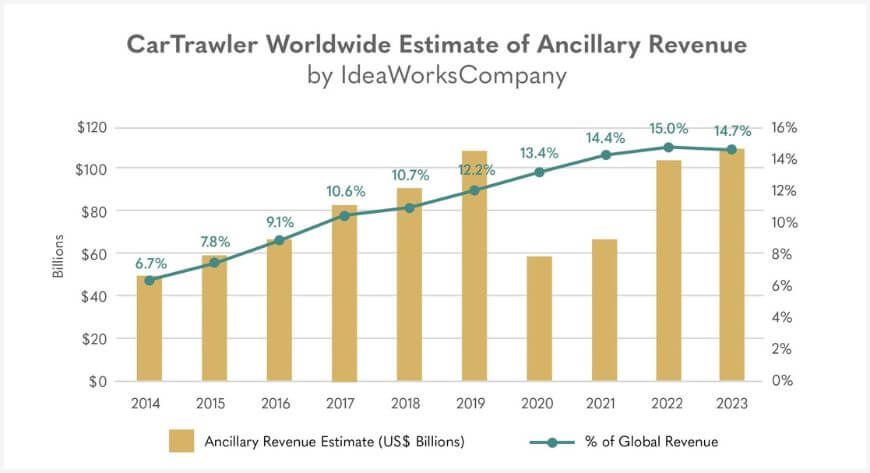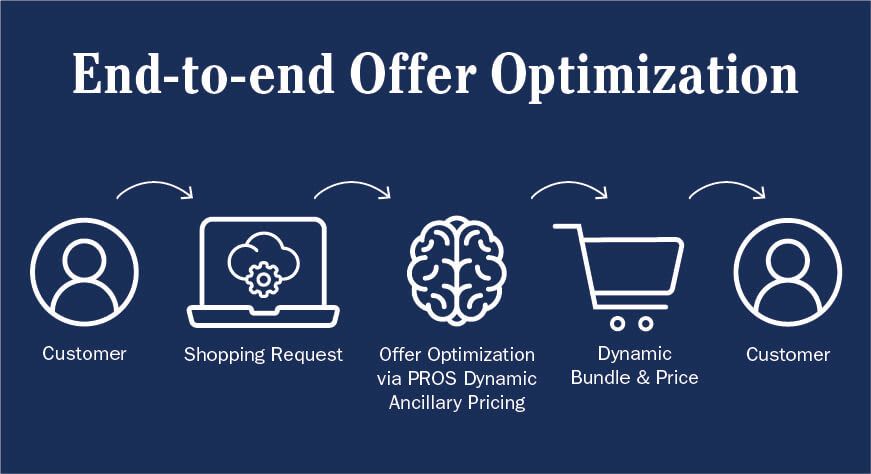The airline industry is well-known for notoriously thin margins and low revenue per passenger. The latest 2024 industry profitability outlook from IATA projects 3.1% net profit margin and $6.14 earning per passenger. As global passenger volumes continue to grow, ancillary sales become a mandatory revenue stream for airlines of all sizes and business models to harness and drive profitability. According to CarTrawler/IdeaWorks Company report the revenue potential of ancillaries keeps growing, surpassing pre-pandemic levels and reaching $117.9 billion worldwide for 2023.

Ancillary revenue estimate by CarTrawler/IdeaWorks Company
So how can airlines deploy a revenue management strategy for ancillary sales? At PROS, we look at ancillary revenue optimization as centered around two major decisions travelers decide on:
- The itinerary they want to take based on the schedule and price, and
- The extra features, or ancillaries, that they want to include.
You can read all about the value that number one provides for maximizing airline revenue through dynamic pricing here. This article will discuss number two — ancillaries. The combination of one and two together make up what we call Airline Offer Optimization. It’s the process of optimizing the entire offer that is presented to the customer and ensuring the most revenue potential is recognized for the airline.
Defining Airline Ancillary Optimization
As the focus is turned to ancillaries, it’s important to highlight where the value comes from to the airline, as well as to customers. The three key areas that define the PROS approach to Dynamic Ancillary Pricing are: ranking, bundling, and pricing ancillaries. Each one of these can drive incremental revenue benefits for the airline, while bringing a better customer experience for the passenger making the purchase.
Ancillary Ranking
For many airlines, there are a lot of ancillaries for a passenger to choose from. Simply the order in which those are displayed to the passenger can have a significant impact to the buying behavior and the likelihood of conversion. There are a few reasons why this is important:
- Choice: In many cases, the passenger is fatigued with the long catalog of optional products and services once presented with too many options. Thus, airlines need to focus on relevance rather than quantity to make it easy and fast for customers to choose and purchase.
- Order and Elasticity Forecasting: The customer may have a limited amount of money available to spend on ancillaries, so the order in which they are displayed can ensure that the airline maximizes revenue by presenting the ancillaries in the right order. For example, let’s say that an airline has Wi-Fi for $8, drinks for $10, and seat selection for $25. And let’s assume that the passenger has $30 she’s looking to spend on ancillaries. Depending on the way the airline presents this to her, if she chooses Wi-Fi and a drink pass, the airline will make $18 in revenue, but the passenger is out of money to spend. However, if presented with seat selection first, she would have made that choice, giving the airline $25 in revenue.
- Segmentation: Customer characteristics dictate different likelihood of buying certain ancillaries. Something as simple as market characteristics, like a beach destination, could be important to consider and ensure that ancillaries like golf bags and surfboards are presented first to lead to better conversion.
PROS AI has been used to optimize ancillary ranking in a live airline trial, driving 0.5% conversion uplift and proving that this is just the starting point for driving revenue growth with PROS Dynamic Ancillary Pricing (DAP).
Ancillary Bundling
Building on the momentum from ranking, the natural next step is to upsell by grouping ancillaries together in bundles with a higher likelihood to purchase. This can be done with or without changing the price. The perception of getting a bundle alone can lead to higher conversions.

Ancillary Bundling
Imagine the customer was presented with a bundle of Wi-Fi and Lounge for $40. Despite having a total price elasticity of $30, seeing a bundle could be enough to entice the passenger into spending the extra $10. Paired with the right data, the price for the bundle could even be adjusted if the data supports that decision, to ensure conversion. As with ranking of ancillaries, the right science and customer segmentation through their attributes is critical to maximize ancillary revenue.
Ancillary Pricing
PROS Dynamic Ancillary Pricing (DAP) is where things get exciting and the real revenue opportunity for the airlines comes to light. PROS DAP leverages AI to dynamically set the price of ancillary products based on static dimensions (like day of week), as well as based on market conditions and customer attributes. It considers granular customer segmentation and real-time data about the shopping request to provide a dynamic optimal price most likely to convert shoppers. Thanks to reinforcement learning PROS DAP uses the latest booking data to continuously learn and enhance its AI models and evolve ancillary pricing.
Historical information is obviously important to driving what you should do in the future. Airlines that have been deploying robust rule-based merchandising techniques through PROS Offer Creation solutions or other, are well poised for AI-based ancillary optimization. It enables them to automate a lot of existing manual business rules, improving team efficiency and reducing human error, while scientifically calculating optimal ancillary pricing.
airBaltic is one of the carriers that leverages PROS merchandising technology to fully manage a dynamic ancillary catalogue and personalize offers based on granular customer and market segmentation. Today, the airline is advancing their eCommerce with AI-fueled seat assignment pricing that has driven a 6% ASR revenue increase per passenger:

However, many airlines often present static ancillary catalogs. So, what do you do if your historical data has little or no variability? For example, let’s say that for seat selection, you have only ever charged $25. Any predictive model is simply going to take in the observations of $25 and suggest a price of, you guessed it, $25. That’s not revenue optimal.
This is where artificial intelligence and the idea of reinforcement learning models come in. You must pair the predictive element of the AI with an inferential element. That means you need to intentionally introduce variability into the price, in a very controlled way. Those prices are then used in the model to update what the right price is for the given dimensions, market conditions, and/or customer attributes. The model can then quickly learn, or infer, through the interactions of the different observations what the right price is for the particular request, and customer. The AI behind this is cutting edge for the industry, helping airlines move away from static ancillary pricing and driving higher revenue per passenger.

Ancillary Distribution
Of course, you can come up with the best prices for ancillaries but getting those to your passengers efficiently is just as important and PROS can help in that area too. Combining the power of PROS Dynamic Ancillary Pricing with our Offer Creation and Retailing solutions creates the end-to-end solution. It receives the request from the airline.com, makes the call to the merchandising system, responds with the dynamic bundle and price, and returns that to present to the customer, all in an integrated workflow between PROS DAP, PROS Merchandising and the airline’s booking engine. The result – offer optimization delivered.
So, if you are looking for ancillary revenue optimization software, contact PROS and we are happy to demo PROS Dynamic Ancillary Pricing solution
Frequently Asked Questions
Dynamic ancillary pricing is a strategy where airlines adjust the prices of their extra products and services — like seat selection, Wi-Fi, or extra baggage — in real-time. Instead of using fixed prices, this approach considers market conditions and specific account details to set the best price at the moment of purchase, helping to increase revenue from these sales.
There are three main strategies to get the most out of ancillary sales:
Ranking: Displaying ancillary options in a specific order can guide customer choices. Presenting the most relevant or profitable options first can lead to higher conversion rates and revenue, especially when customers have a limited budget for extras.
Bundling: Grouping related ancillaries together into a single package can encourage passengers to spend more than they might have otherwise. The appeal of a bundle can lead to higher conversions, even if the price is slightly higher.
Dynamic Pricing: This involves using AI to scientifically determine the optimal price for each ancillary product based on granular customer segments and real-time shopping data. It helps airlines move away from static pricing to find the price most likely to convert.
The airline industry operates on very thin profit margins. Ancillary sales have become a critical revenue stream to boost overall profitability. As passenger numbers grow, optimizing the sale of these extras is no longer just an option, but a necessary part of a successful revenue management strategy.
Even if an airline has limited historical price variation, AI can still be effective. Modern systems, like those from PROS, use reinforcement learning. This approach intentionally introduces small, controlled price variations to see how customers react. The AI model then learns from these interactions to infer the right price for different situations, quickly moving the airline toward a more profitable, dynamic strategy.
Yes. Leading carriers are already using this technology to increase revenue. For example, airBaltic implemented AI-fueled seat assignment pricing using PROS technology and saw a 6% increase in ancillary seat revenue per passenger. This shows how scientific pricing for ancillaries can deliver measurable financial benefits.
PROS provides an end-to-end solution for offer optimization. PROS Dynamic Ancillary Pricing (DAP) uses AI to calculate the best price, rank, and bundle for ancillaries. When combined with PROS Merchandising and Offer Creation solutions, airlines can seamlessly deliver these offers to customers through their booking channels, ensuring the entire process is efficient and optimized for revenue.
